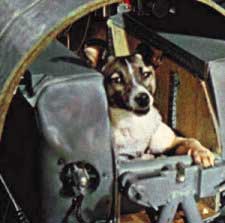'Four-legged astronauts'
Humans often refer to Laika dogs - animals that are considered pioneers in paving the way for life to orbit the earth. But the truth is not only Laika but also many other dogs participating in these tests.
 Laika on Sputnik 2 ( Photo: Spacetoday )
Laika on Sputnik 2 ( Photo: Spacetoday )
The day Yuri Gagarin flew into space, marked the era of conquest of the immense space of mankind. In order to get that important milestone, scientists had to go through many experiments with the launch of the spacecraft. First of all, two dogs named Digan and Dezik were launched into space by Soviet boosters in July 1951. This test was successful, and Digan and Dezik returned to Earth safely in the grounded compartment.
In the following years, the tests were continued with increasingly improved conditions and equipment. Dozens of dogs were launched into the air by the rocket to find a solution to life in the air. However, these tests cannot be 'astronauts', because flights have not yet crossed the atmosphere to reach the earth's orbit.
On October 4, 1957, with a rocket of nearly 25,000 km / h, the Soviet Union was the first country to have won the attraction of the earth, bringing Sputnik 1 satellite into orbit. Only one month later, on November 3, 1957, the first test flight as a true space trip with the dog Laika on the Sputnik 2 was conducted. Sputnik 2 weighs more than half a ton with the scientific equipment used to measure the solar radiation, check the properties of the atmospheric layers as well as Laika 's biological index monitoring devices flew 2,570 rounds. around the earth within 7 days. However, because the information about Laika 's life in those six short hours was extremely valuable for the preparations to bring people into space.
After Laika , there were many other dogs brought up by Soviet scientists. In August 1960, the test flight with two dogs Belka and Strelka achieved great success. These two "four-legged astronauts" have returned to Earth safely after flying 17 rounds of orbit, quite solemnly received. This victory has proved that, with current techniques that allow people to live and work on earth orbit. Believed about the flight, Jacqueline Kennedy - wife of US President John F. Kennedy, sent a congratulatory message to the Soviet leaders and asked for one of Strelka 's descendants. In response to the request, the Soviet side sent her white dog, Puchok , Strelka 's son
 Two Russian dogs Belka and Strelka ( Photo: Spacetoday )
Two Russian dogs Belka and Strelka ( Photo: Spacetoday )
Four months after the flight of Belka and Strelka , in December 1960, the test flight with two dogs Alpha and Zhulka did not return the expected results. The ship was in trouble, the storage chamber was forced to flee the ship outside the original plan. The parachute carrying the chamber containing Alpha and Zhulka fell into the wild Siberi region. But miraculously, these two little astronauts still live healthy. Four months later, Archbishop Sergei Korolev made a test flight with the Zvedochka (Little Star). It is said that it was originally called Udachi (Victory) but when it was about to launch, it was Yuri Gagarin who renamed it.
With this name, the Zvedochka dog entered the aerospace history after successfully performing a flight with nearly the same conditions as Yuri Gagarin's flight on both machines, flight times and landing conditions. With the results, Soviet scientists decided to launch the Oriental 1 ship, bringing Yuri Gagarin's first human astronaut into space, opening the era of immense conquest.
- Why is there absolutely no three-legged creature on Earth?
- 'Four-legged snake' appeared in Hanoi
- Sitting cross-legged - Causes of many diseases
- Discover Big Legs in the forest with 2 children?
- Find the fossil of 4-legged animals at the earliest
- Controversy over 4-legged fossils
- Two-legged dog with the strength of the person who must respect
- Found 7-legged frog
- Eat by science
- Built a six-legged robot
- 6-leg beetle
- What is this 'three-legged tripod' in every pizza box used for?
 Van Allen's belt and evidence that the Apollo 11 mission to the Moon was myth
Van Allen's belt and evidence that the Apollo 11 mission to the Moon was myth The levels of civilization in the universe (Kardashev scale)
The levels of civilization in the universe (Kardashev scale) Today Mars, the sun and the Earth are aligned
Today Mars, the sun and the Earth are aligned The Amazon owner announced a secret plan to build a space base for thousands of people
The Amazon owner announced a secret plan to build a space base for thousands of people